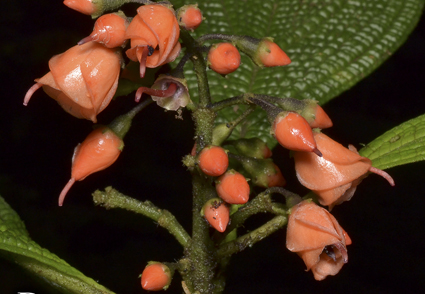Abstract
Meriania judithiae, a new species from the southeast of Morona Santiago in Ecuador, is described and illustrated. With this new addition, the number of species of the genus increases to 33 in this country. Meriania judithiae has leaves with a attenuate base extending down the petiole as wings, multiflorous inflorescences with sub-umbellate paraclades, pink-orange campanulate flowers, the calyx with conical projections, and isomorphic stamens with connectives prolonged below the thecae. It is compared with M. cuneifolia, its most similar species which shares the distant supra-basal venation and gradually narrowing base of the leaves. In addition, the taxonomic similarities of the new entity are discussed and information about its distribution, habitat, and conservation status is provided.
References
- Báez, S., Santiana, J. & Guevara, J. (2013) BsBn02. Bosque siempreverde montano bajo del Sur de la Cordillera Oriental de los Andes. Ministerio del Ambiente del Ecuador. Sistema de Clasificación de los Ecosistemas del Ecuador Continental de los Andes. Ministerio del Ambiente del Ecuador, Quito, pp. 121–123.
- Beentje, H. (2016) The Kew Plant Glossary: an illustrated dictionary of plant terms. Second Edition. Kew Publishing, Royal Botanical Gardens, Kew, Richmond, United Kingdom, 184 pp.
- Fernández-Fernández, D. (2010) Análisis cladístico de las especies ecuatorianas del género Meriania (Melastomataceae) basado en caracteres morfológicos y molecualres. Tesis Master. Universidad Internacional Menéndez Pelayo, España, 93 pp.
- Fernández-Fernández, D.M., Jost, L. & Dellinger, A.S. (2020) Two new species of Meriania (Melastomataceae) from eastern Ecuador. Phytotaxa 458 (1): 1–14. https://doi.org/10.11646/phytotaxa.458.1.1
- Fernandez-Hilario, R., Goldenberg, R. & Michelangeli, F.A. (2021) Two new species and two new country records for Meriania (Melastomataceae) from northern Peru. Nordic Journal of Botany 39: 1–16. https://doi.org/10.1111/njb.02969
- Fernandez-Hilario, R., Gonzáles, R. del P.R., Villanueva-Espinoza, R., Lajo, L., Sato, A.A.W., Paredes-Burneo, D., Pillaca-Huacre, L., Michelangeli, F.A. & Goldenberg, R. (2022) Nine new species and a new country record for Meriania (Melastomataceae) from Peru. Willdenowia 52: 39–74. https://doi.org/10.3372/wi.52.52103
- Fernandez-Hilario, R., Goldenberg, R. & Michelangeli, F.A. (2023) A synopsis of Meriania (Melastomataceae: Merianieae) in Peru. Phytotaxa 602 (1): 1–101. https://doi.org/10.11646/phytotaxa.602.1.1
- GBIF (2024) Global Biodiversity Information Facility. Facilitated by the GBIF Secretariat. Available from: http://www.gbif.org/ (accessed 1 June 2024)
- Gleason, H.A. (1947) New and noteworthy melastomes, chiefly Ecuadorian. Phytologia 2: 294–306.
- Goldenberg, R., Meyer, F.S. & Michelangeli, F.A. (2020) Taxonomic notes in Meriania (Melastomataceae) from the Brazilian Atlantic Forest, including a new species, a resurrected one and a new synonym. Phytotaxa 453 (3): 218–232. https://doi.org/10.11646/phytotaxa.453.3.4
- IUCN (2024) Guidelines for Using the IUCN Red List Categories and Criteria. Version 16. Prepared by the Standards and Petitions Committee. Available from: http://www.iucnredlist.org/documents/RedListGuidelines.pdf (accessed 11 July 2024)
- Jiménez, M.M., Iturralde, G.A., Fierro Minda, A., Ocupa-Horna, L., Mendoza, J. & Garzón-Suárez, H.X. (2024) A new species of Meriania (Melastomataceae: Merianieae) with winged hypanthium from the Cordillera del Condor in Ecuador. Phytotaxa 636 (1): 73–86. https://doi.org/10.11646/phytotaxa.637.1.5
- Luteyn, J.L. & Wilbur, R.L. (1977) New genera and species of Ericaceae (Vaccinieae) from Costa Rica and Panama. Brittonia 29: 255–276. https://doi.org/10.2307/2806199
- Martius, C.F.P. von (1843) Amara. Amara cum principio adstringente. Meliaceae. In: Missouri Botanical Garden (Org.) Systema materiae medicae vegetabilis brasiliensis. Fleischer, Lipsiae, pp. 37–38. https://doi.org/10.5962/bhl.title.9541
- Mendoza-Cifuentes, H. (2021) Taxonomic review of the genus Meriania (Melastomataceae) in Colombia. Acta Botánica Mexicana 128: e1734. https://doi.org/10.21829/abm128.2021.1734
- Michelangeli, F.A., Carmenate Reyes, W. & Sosa, K. (2015) A revision of Meriania (Melastomataceae) in the Greater Antilles with emphasis on the status of the Cuban species. Brittonia 67: 118–137. https://doi.org/10.1007/s12228-015-9366-4
- Michelangeli, F.A., Dellinger, A.S., Goldenberg, R., Almeda, F., Mendoza-Cifuentes, H., Fernández-Fernández, D., Ulloa Ulloa, C. & Penneys, D.S. (2022) Phylogenetics and Taxonomy of the Tribe Merianieae. In: Goldenberg, R., Michelangeli, F.A. & Almeda, F. (Eds.) Systematics, Evolution, and Ecology of Melastomataceae. Springer Nature Switzerland AG, Cham, pp. 255–273. https://doi.org/10.1007/978-3-030-99742-7_11
- Ministerio del Ambiente del Ecuador (2013) Sistema de Clasificación de los Ecosistemas del Ecuador Continental. Subsecretaría de Patrimonio Natural, Quito, Ecuador, 300 pp.
- Penneys, D.S., Almeda, F., Reginato, M., Michelangeli, F.A., Goldenberg, R., Fritsch, P.W. & Stone, R.D. (2022) A new Melastomataceae classification informed by molecular phylogenetics and morphology. In: Goldenberg, R., Michelangeli, F.A. & Almeda, F. (Eds.) Systematics, Evolution, and Ecology of Melastomataceae. Springer Nature Switzerland AG, Cham, pp. 109–165. https://doi.org/10.1007/978-3-030-99742-7_5
- Ruiz, H. & Pavón, J. (1794) Florae Peruvianae, et Chilensis Prodromus. Imprenta de Sancha, Madrid, 153 pp.
- Smith, A.C. (1950) Studies of South American plants, XII. Contributions from the United States National Herbarium 29: 317–393.
- Swartz, O. (1798) Flora Indiae Occidentalis aucta atque illustrata: sive, Descriptiones plantarum in prodromo recensitarum (Vol. 2). Erlangae, Sumtu J.J. Palmii, pp. 643–1232. Available from: http://www.biodiversitylibrary.org/page/3605654#page/603/mode/1up (accessed 8 February 2024)
- Thiers, B. (2024-continuously updated) Index Herbariorum. Part I: The herbaria of the world. New York Botanical Garden. Available from: http://sweetgum.nybg.org/science/ih/ (accessed 11 July 2024)
- Triana, J.J. (1866) Dispositio Melastomacearum. Bulletin du Congress International de Botanique et d’Horticulture. Stefanus Mostert & Fild. Rotterdam, pp. 457–461.
- Tropicos.org (2024) Facilitated by the Missouri Botanical Garden. Available from: http://tropicos.org/ (accessed 16 April 2024)
- Ulloa Ulloa, C., Almeda, F., Goldenberg, R., Kadereit, G., Michelangeli, F.A., Penneys, D. Stone, R.D. & Veranso-Libalah, M.C. (2022) Melastomataceae: Global diversity, distribution, and endemism. In: Goldenberg, R., Michelangeli, F.A. & Almeda, F. (Eds.) Systematics, Evolution, and Ecology of Melastomataceae. Springer Nature Switzerland AG, Cham, pp. 3–28. https://doi.org/10.1007/978-3-030-99742-7_1
- Wurdack, J.J. (1957) Certamen Melastomataceis—IV. Brittonia 9: 101–109. https://doi.org/10.2307/2804774
- Wurdack, J.J. (1986) Atlas of hairs for Neotropical Melastomataceae. Smithsonian Contributions to Botany 63: 1–80. https://doi.org/10.5479/si.0081024X.63
- Wurdack, J.J. (1976) Certamen Melastomataceis XXV. Phytologia 35: 1–13. https://doi.org/10.5962/bhl.part.2606
- Wurdack, J.J. (1979) Certamen Melastomataceis XXX. Phytologia 43: 347–348.
- Vellozo, J.M. da C. (1829) 180. Trichilia. Monogynia. Decandria. Classis I. Florae Fluminensis, seu, Descriptionum plantarum parectura Fluminensi sponte mascentium liber primus ad systema sexuale concinnatus Flumine Januario. Ex Typographia Nationali, Rio de Janeiro, pp. 175–176. https://doi.org/10.5962/bhl.title.745


